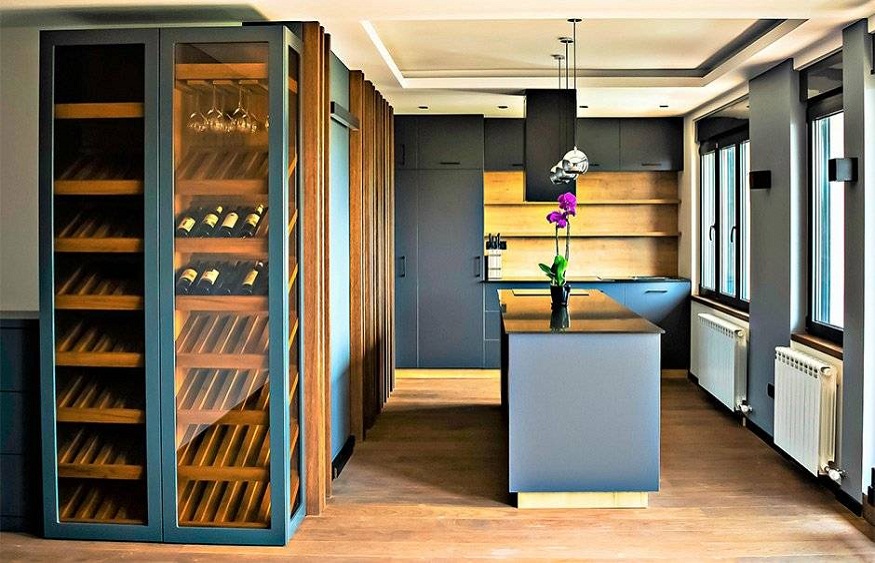What a dilemma! Your dining room and your living room are one and the same open space and you wonder how much space you should devote to the living room and how much to the kitchen? And how to harmonize everything?
Do not panic ! I give you here some tips that will guide you in the development of a friendly, functional and successful space.
When you have a large room to decorate and arrange in several spaces, you want above all that your decor is harmonious.
Here are some key things you’ll need to consider to achieve your goal.
First, make sure the same flooring covers the whole space , this is essential so that it looks bigger.
Then, to make the decor of your open-plan room cohesive, paint all the walls the same color . The doors, moldings and frames can be painted in another color, ideally in a shade of the main color or in white or cream if you absolutely do not want to be mistaken. Sometimes certain architectural details such as an alcove will benefit from being highlighted by an accent color, it will then be up to you to judge.
To unify the space, I also advise you to use materials. Whether it is the use of the same type of wood in the selection of your furniture , the repetition of the same window dressing , or the duplication of the fabric covering of your dining room chairs into decorative cushions in the living room, all will be used to harmonize your room.
Distribution of spaces
When an open-plan room must accommodate both a living room and a dining room, the normal proportions are to take 1/3 for the dining room and 2/3 for the living room. Since we normally spend more time in the living room than in the dining room, it is normal to distribute the space in this way.
However, if your lifestyle means you often have people around the table for a meal, then maybe you should consider dividing up the space on a 50/50 ratio.
We are also seeing more and more spaces without a dining room, with owners preferring the lounge area and using the kitchen island as a dining area.
The important thing here is to know your lifestyle well and to delimit your kitchen and living room areas accordingly.
Furniture positioning
The positioning of the furniture in space is obviously affected by the shape of the room (rectangular, narrow, square, in “L”), the location of various fixed elements including windows, doors, and fireplaces and the circulation area from one space to another.
In order to create divisions between the living room area and that of the dining room, you will have to use so-called psychological divisions.
Here are some typical layouts you can use to divide your space.
If you lean your sofa against the longest wall in your room, you can use one or two accent chairs or ottomans to visually separate the spaces. Add an area rug and canvas or a picture arrangement centered on the sofa to further define the space.
In this position, the sofa will frequently find itself facing the entrance to the room and will thus invite relaxation and conviviality, as it will be the center of attraction in the living room.
If your living room has a fireplace or a television, then the sofa will either be positioned facing it or installed under a window perpendicular to the fireplace and facing the open space. In both scenarios, using accent chairs will allow you to add seating, keep the space open, and energize your decor.
You can also use the sofa or a sectional as a dividing element with the dining room if your space allows it. To hide the back of the sofa, lean against it a console table or low cabinet that can also be used as a sideboard during meals with friends and for additional storage.
If your space is more square, opt for a square or round table to maximize circulation area. A small shelf attached to the wall and topped with a beautiful mirror will provide a focal point to the space and make the room appear larger. If you have the space, however, add a small console table for more visual interest in the room and for additional storage.
A rectangular space naturally calls for a similarly shaped dining table. If, for reasons of room width, circulation is difficult, use a bench or a bench. This will allow you to lean or bring the table closer to the wall. It can then easily be removed from the wall during meals with friends.
A square, round or oval table can also be suitable for this room shape. Take full advantage of the space by using a low sideboard or credenza to add storage and balance the space.
In closing, before you start buying several pieces of furniture at the same time, I advise you to first consider your lifestyle and buy the main elements that correspond to it first. Then gradually add all these small pieces of furniture and decor such as occasional chairs, rugs, sideboards and others that will balance and energize your open space.



